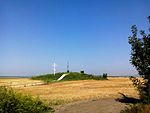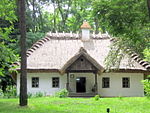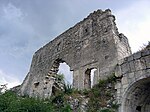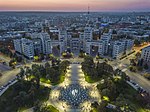List of World Heritage Sites in Ukraine
The United Nations Educational, Scientific and Cultural Organization (UNESCO) designates World Heritage Sites of outstanding universal value to cultural or natural heritage which have been nominated by countries that are signatories to the UNESCO World Heritage Convention, established in 1972.[1] Cultural heritage consists of monuments (such as architectural works, monumental sculptures, or inscriptions), groups of buildings, and sites (including archaeological sites). Natural heritage is defined as natural features (consisting of physical and biological formations), geological and physiographical formations (including habitats of threatened species of animals and plants), and natural sites which are important from the point of view of science, conservation or natural beauty.[2] Ukraine officially adopted the UNESCO Convention and become an independent member on 12 October 1988,[3] while still officially being a Union Republic of the Soviet Union (prior to its dissolution in 1991[4]).
As of 2023[update], there are eight World Heritage Sites listed in Ukraine, seven of which are cultural sites and one of which, the
World Heritage Sites
UNESCO lists sites under ten criteria; each entry must meet at least one of the criteria. Criteria i through vi are cultural, and vii through x are natural.[6]
| Site | Image | Location | Year listed | UNESCO data | Description |
|---|---|---|---|---|---|
| Kyiv: Saint-Sophia Cathedral and Related Monastic Buildings, Kyiv Pechersk Lavra †
|

|
Kyiv | 1990 | 527ter; i, ii, iii, iv (cultural) | The Saint-Sophia Cathedral was constructed in the 11th century, soon after the |
| L'viv – the Ensemble of the Historic Centre† | 
|
Lviv Oblast | 1998 | 865bis; ii, v (cultural) | The city of L'viv was founded in the late |
| Struve Geodetic Arc* | 
|
Khmelnytskyi Oblast, Odesa Oblast | 2005 | 1187; ii, iii, vi (cultural) | The Struve Geodetic Arc is a series of triangulation points, stretching over a distance of 2,820 kilometres (1,750 mi) from Hammerfest in Norway to the Black Sea. The points were set up in a survey by the astronomer Friedrich Georg Wilhelm von Struve who first carried out an accurate measurement of a long segment of a meridian, which helped to establish the size and shape of Earth. Originally, there were 265 station points. The World Heritage Site includes 34 points in 10 countries (North to South: Norway, Sweden, Finland, Russia, Estonia, Latvia, Lithuania, Belarus, Moldova, Ukraine), four of which are in Ukraine (site marker in Felshtyn pictured).[9] |
| Ancient and Primeval Beech Forests of the Carpathians and Other Regions of Europe* | 
|
Ivano-Frankivsk, Khmelnytskyi, Lviv, Zakarpattia oblasts | 2007 | 1133ter; ix (natural) | This site comprises undisturbed examples of Mediterranean, and Pyrenees. The site was originally listed in 2007 as the Primeval Beech Forests of the Carpathians, shared by Slovakia and Ukraine, extended in 2011 to include the Ancient Beech Forests of Germany, and further extended in 2017 and 2021 to include forests in a total of 18 countries. In Ukraine, 13 forest reserves are listed (Synevyr pictured).[10]
|
| Residence of Bukovinian and Dalmatian Metropolitans | 
|
Chernivtsi Oblast | 2011 | 1330; ii, iii, iv (cultural) | The Residence of Bukovinian and Dalmatian Metropolitans was built for the Czech architect Josef Hlávka. The ensemble is built in the historicist style and combines features of Byzantine, Gothic, and Baroque architecture. The complex served as the bishop's residence until World War II. In 1955, the property was transferred to Chernivtsi University.[11]
|
Ancient City of Tauric Chersonese and its Chora
|

|
Sevastopol | 2013 | 1411; ii, v (cultural) | The city was founded by Dorian Greeks in the 5th century BCE on the coast of the Black Sea. In the following centuries, the city saw the interactions of Greek, Roman, and Byzantine communities in the Black Sea region. It was ultimately abandoned in the 15th century. The area around the city was important due to its wine production, and the remains of ancient vineyards have been well preserved.[12] |
| Wooden Tserkvas of the Carpathian Region in Poland and Ukraine* | 
|
Ivano-Frankivsk, Lviv, Zakarpattia oblasts | 2013 | 1424; iii, iv (cultural) | This property comprises 16 wooden churches (tserkvas) in the Greek Catholic faiths. The designs are based on the Orthodox ecclesiastical traditions with local influences. They feature wooden bell towers, iconostasis screens, and interior polychrome decorations, as well as churchyards, gatehouses, and graveyards. The Holy Trinity Church in Zhovkva is pictured.[13]
|
| The Historic Centre of Odesa† | 
|
Odesa Oblast | 2023 | 1703; i, ii, iii, iv, v (cultural) | The city of Odesa rapidly developed as a port city in the late 18th and 19th centuries. A multicultural city, it was home to |
Tentative list
In addition to the sites on the World Heritage list, member states can maintain a list of tentative sites that they may consider for nomination. Nominations for the World Heritage list are only accepted if the site has previously been listed on the tentative list.[16] As of 2023[update], Ukraine has 16 sites on its tentative list.[3]
| Site | Image | Location | Year listed | UNESCO criteria | Description |
|---|---|---|---|---|---|
| Historic Centre of Tchernigov, 9th—13th centuries | 
|
Chernihiv Oblast | 1989 | i, ii, iv (cultural) | This nomination comprises the historic centre of Tchernigov, or Chernihiv, that dates to the 9th—13th centuries. The nomination mentions the Transfiguration Cathedral from the 11th century and the Borysohlibskyi Cathedral from the 12th century (pictured).[17] |
| Cultural Landscape of Canyon in Kamenets-Podilsk | 
|
Khmelnytskyi Oblast | 1989 | i, ii, iv (cultural) | This nomination comprises the castle (pictured) and the historic centre of the city Kamianets-Podilskyi, dating from the 11th to the 18th centuries.[18] |
| Tarass Shevtchenko Tomb and State Historical and Natural Museum - Reserve | 
|
Cherkasy Oblast | 1989 | (mixed) | No description provided in the nomination documentation[19] |
| National Steppe Biosphere Reserve "Askaniya Nowa" | 
|
Kherson Oblast | 1989 | x (natural) | No description provided in the nomination documentation[20] |
| Dendrological Park "Sofijivka" | 
|
Cherkasy Oblast | 2000 | (mixed) | The construction of the English landscape park was started in 1796 by Stanisław Szczęsny Potocki. It is a representative example of the landscape gardening architecture at the turn of the 18th century and is home to over two thousand plant species. Since 1955, it has been managed by the National Academy of Sciences of Ukraine.[21] |
Bagçesaray Palace of the Crimean Khans
|

|
AR Crimea | 2003 | i, iii, v, vi (cultural) | The palace was constructed in the first half of the 16th century in the local period style. It served as the residence of Crimean Khans for around 250 years. The complex comprises two mosques, official buildings, living quarters of the Khans and their families, as well as auxiliary buildings, inner courtyards and parks.[22] |
| Archaeological Site "Stone Tomb" | 
|
Zaporizhzhia Oblast | 2006 | iii, vi (cultural) | This archaeological site encompasses a large mound, up to 12 metres (39 ft) tall, made up of individual sandstone blocks. There are several petroglyphs on the stones, some dating to the Neolithic period while most were created in the Bronze Age. Remains of settlements from the Mesolithic and Neolithic periods have been found in the area.[23] |
| Mykolayiv Astronomical Observatory | 
|
Mykolaiv Oblast | 2007 | ii, iv (cultural) | The Mykolayiv was founded in 1821 as a naval observatory. The complex comprises the Classicist main building, astronomic pavilions from the early 20th century, and three modern pavilions that are in use for research.[24]
|
| Complex of the Sudak Fortress Monuments of the 6th – 16th c. | 
|
AR Crimea | 2007 | ii, iv, v (cultural) | The fortifications at Sudak, or Sugdeia, were constructed by the Byzantines in the Early Middle Ages and then by the Genoese who built most of the extant structures in the 14th and 15th centuries. Sudak declined in importance in the 17th century and the fortress became a museum in 1958.[25] |
| Astronomical Observatories of Ukraine* | 
|
Mykolaiv Oblast, Kyiv, Odesa Oblast, AR Crimea | 2008 | ii, iv, vi (cultural) | This transnational nomination brings together important astronomical observatories. Four observatories from the 19th and 20th centuries in Ukraine are included in the nomination: Mykolaiv Observatory, Astronomical Observatory of Kyiv National University, Astronomical Observatory of Odesa National University, and Crimean Astrophysical Observatory (pictured).[26] |
| Kyiv: Saint Sophia Cathedral with Related Monastic Buildings, St. Cyril's and St. Andrew's Churches, Kyiv-Pechersk Lavra (extension of Kyiv: Saint-Sophia Cathedral and Related Monastic Buildings, Kyiv-Pechersk Lavra) | 
|
Kyiv | 2009 | i, ii, iii, iv (cultural) | This nomination considers the addition of two churches to the existing World Heritage Site in Kyiv. St. Cyril's Monastery is an important example of Kievan Rus' architecture. It was founded in the 12th century. The interior of the church has been largely preserved while the exterior has been renovated in Baroque style in the 17th and 18th centuries. St. Andrew's Church (pictured) was built in the mid-18th century following the designs of Francesco Bartolomeo Rastrelli. It is a rare example of Elizabethan Baroque in Ukraine.[27] |
| Trading Posts and Fortifications on Genoese Trade Routes. From the Mediterranean to the Black Sea* | 
|
AR Crimea | 2010 | ii, iv (cultural) | This transnational nomination brings together some of the most significant sites of maritime and mercantile settlements distributed around the Mediterranean and the Black Sea that were part of the trade network of Republic of Genoa between the 11th and 15th centuries. In Ukraine, the Sudak fortress is nominated.[28]
|
| Cultural Landscape of "Cave Towns" of the Crimean Gothia | 
|
AR Crimea | 2012 | iii, v, vi, vii (mixed) | This nomination comprises two medieval settlements of Eski-Kermen, as well as the surroundings with limestone formations and man-made caves. The Goths settled the area in the 3rd to 4th centuries and allied with the Byzantine Empire in the 6th century. Mangup was their capital. The Principality of Theodoro formed in the area in the 14th century and was ultimately destroyed by the Ottomans in 1475.[29]
|
| The historical surroundings of Crimean Khans' capital in Bakhchysarai | 
|
AR Crimea | 2012 | ii, iii, v, vi (cultural) | This nomination comprises the Khan's palace and the fortress of Chufut-Kale (ruins pictured), as well as their surroundings. The palace was constructed in the first half of the 16th century and served as the residence of Crimean Khans for around next 250 years. The area around Chufut-Kale was home to Alans from the 6th to the 15th century. It served as the first capital of Crimean Tatars in the 14th century. Between the 17th and 19th centuries, Crimean Karaites became the largest ethnic group in the city. Most of the archaeological remains are from this period.[30]
|
| Derzhprom (the State Industry Building) | 
|
Kharkiv Oblast | 2017 | iv (cultural) | Derzhprom, or the State Industry Building, is located at the side of the Freedom Square in Kharkiv. Built in the 1920s, it is the world's largest building in constructivist style. It was designed by architects S.S. Serafnnov, M.D. Feldher, and S.M. Kravets. Derzhprom made modernism the main architectural style of the Soviet Union for several years.[31] |
| Tyras - Bilhorod (Akkerman), on the way from the Black Sea to the Baltic Sea | 
|
Odesa Oblast | 2019 | ii, iv, vi (cultural) | The Mediterranean. The city, now known as Bilhorod-Dnistrovskyi, was shaped by numerous communities that lived there through centuries.[32]
|
See also
- Intangible cultural heritage of Ukraine
- List of historic reserves in Ukraine
- National parks of Ukraine
- Tourism in Ukraine
References
- ^ "The World Heritage Convention". UNESCO World Heritage Centre. Archived from the original on 27 August 2016. Retrieved 21 September 2010.
- ^ "Convention Concerning the Protection of the World Cultural and Natural Heritage". UNESCO World Heritage Centre. Archived from the original on 1 February 2021. Retrieved 3 February 2021.
- ^ a b c d "Ukraine". UNESCO World Heritage Centre. Archived from the original on 12 May 2021. Retrieved 17 May 2021.
- from the original on March 2, 2022. Retrieved June 2, 2021.
- ^ a b c "Ukraine: UNESCO sites of Kyiv and L'viv are inscribed on the List of World Heritage in Danger". UNESCO World Heritage Centre. Archived from the original on 17 September 2023. Retrieved 17 September 2023.
- ^ "UNESCO World Heritage Centre – The Criteria for Selection". UNESCO World Heritage Centre. Archived from the original on 2016-06-12. Retrieved 17 August 2018.
- ^ "Kyiv: Saint-Sophia Cathedral and Related Monastic Buildings, Kiev-Pechersk Lavra". UNESCO World Heritage Centre. Archived from the original on 12 May 2021. Retrieved 17 May 2021.
- ^ "L'viv – the Ensemble of the Historic Centre". UNESCO World Heritage Centre. Archived from the original on 16 May 2021. Retrieved 17 May 2021.
- ^ "Struve Geodetic Arc". UNESCO World Heritage Centre. Archived from the original on 30 October 2005. Retrieved 16 August 2020.
- ^ "Ancient and Primeval Beech Forests of the Carpathians and Other Regions of Europe". UNESCO World Heritage Centre. Archived from the original on 2 March 2012. Retrieved 1 February 2021.
- ^ "Residence of Bukovinian and Dalmatian Metropolitans". UNESCO World Heritage Centre. Archived from the original on 19 May 2021. Retrieved 17 May 2021.
- ^ "Ancient City of Tauric Chersonese and its Chora". UNESCO World Heritage Centre. Archived from the original on 16 May 2021. Retrieved 17 May 2021.
- ^ "Wooden Tserkvas of Carpathian Region in Poland and Ukraine". UNESCO World Heritage Centre. Archived from the original on 27 October 2020. Retrieved 29 October 2020.
- ^ "The Historic Centre of Odesa". UNESCO World Heritage Centre. Archived from the original on 25 January 2023. Retrieved 25 January 2023.
- ^ "Odesa inscribed on UNESCO's World Heritage List in the face of threats of destruction". UNESCO World Heritage Centre. Archived from the original on 25 January 2023. Retrieved 25 January 2023.
- ^ "Tentative Lists". UNESCO World Heritage Centre. Archived from the original on 29 June 2020. Retrieved 17 August 2021.
- ^ "Historic Centre of Tchernigov, 9th -13th centuries". UNESCO World Heritage Centre. Archived from the original on 22 August 2021. Retrieved 22 August 2021.
- ^ "Cultural Landscape of Canyon in Kamenets-Podilsk". UNESCO World Heritage Centre. Archived from the original on 23 August 2021. Retrieved 22 August 2021.
- ^ "Tarass Shevtchenko Tomb and State Historical and Natural Museum - Reserve". UNESCO World Heritage Centre. Archived from the original on 23 August 2021. Retrieved 22 August 2021.
- ^ "National Steppe Biosphere Reserve Askaniya Nowa". UNESCO World Heritage Centre. Archived from the original on 24 August 2021. Retrieved 22 August 2021.
- ^ "Dendrological Park Sofijivka". UNESCO World Heritage Centre. Archived from the original on 24 August 2021. Retrieved 22 August 2021.
- ^ "Bagçesaray Palace of the Crimean Khans". UNESCO World Heritage Centre. Archived from the original on 18 August 2021. Retrieved 22 August 2021.
- ^ "Archaeological Site Stone Tomb". UNESCO World Heritage Centre. Archived from the original on 18 September 2021. Retrieved 22 August 2021.
- ^ "Mykolayiv Astronomical Observatory". UNESCO World Heritage Centre. Archived from the original on 18 August 2021. Retrieved 22 August 2021.
- ^ "Complex of the Sudak Fortress Monuments of the 6th – 16th c." UNESCO World Heritage Centre. Archived from the original on 28 August 2021. Retrieved 22 August 2021.
- ^ "Astronomical Observatories of Ukraine". UNESCO World Heritage Centre. Archived from the original on 18 August 2021. Retrieved 22 August 2021.
- ^ "Kyiv: Saint Sophia Cathedral with Related Monastic Buildings, St. Cyril's and St. Andrew's Churches, Kyiv-Pechersk Lavra (extension of Kyiv: Saint-Sophia Cathedral and Related Monastic Buildings, Kyiv-Pechersk Lavra)". UNESCO World Heritage Centre. Archived from the original on 26 September 2021. Retrieved 26 September 2021.
- ^ "Trading Posts and Fortifications on Genoese Trade Routes. From the Mediterranean to the Black Sea". UNESCO World Heritage Centre. Archived from the original on 26 September 2021. Retrieved 26 September 2021.
- ^ "Cultural Landscape of "Cave Towns" of the Crimean Gothia". UNESCO World Heritage Centre. Archived from the original on 27 September 2021. Retrieved 26 September 2021.
- ^ "The historical surroundings of Crimean Khans' capital in Bakhchysarai". UNESCO World Heritage Centre. Archived from the original on 28 September 2021. Retrieved 28 September 2021.
- ^ "Derzhprom (the State Industry Building)". UNESCO World Heritage Centre. Archived from the original on 18 September 2021. Retrieved 28 September 2021.
- ^ "Tyras - Bilhorod (Akkerman), on the way from the Black Sea to the Baltic Sea". UNESCO World Heritage Centre. Archived from the original on 18 September 2021. Retrieved 28 September 2021.
